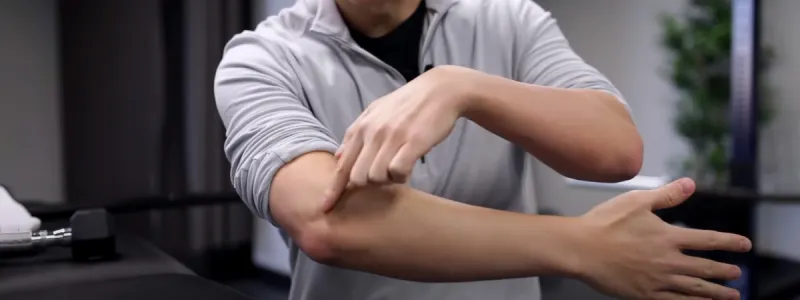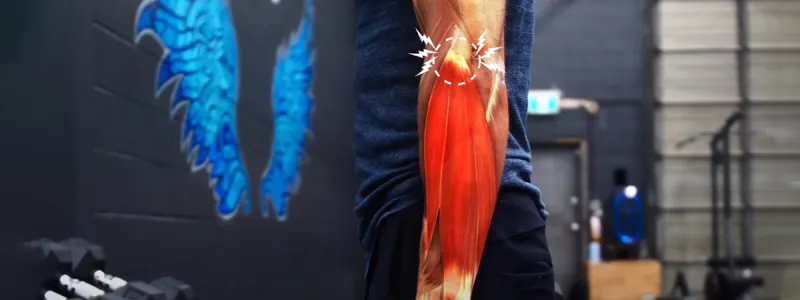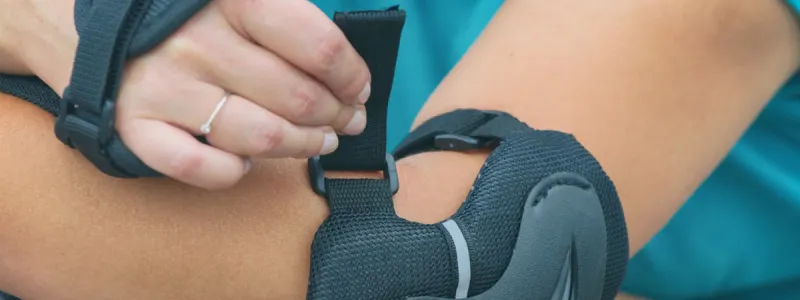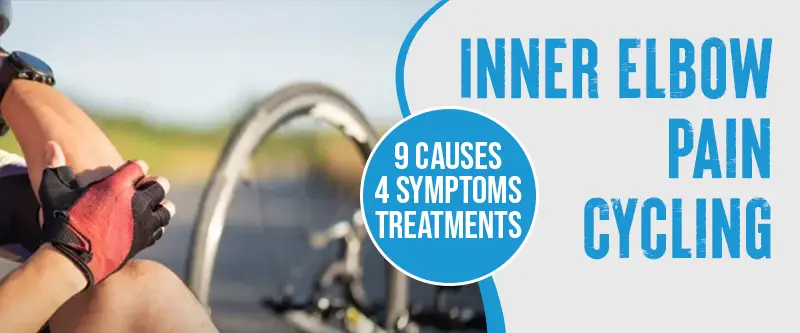The medial epicondylitis, also known as golfer’s elbow, baseball elbow, suitcase elbow, and forehand tennis elbow, can occur during cycling. The elbow experiences pain on the inside (medial side) from the elbow to the wrist. A damaged tendon that bends the wrist toward the palm causes discomfort.
Medial epicondylitis is the leading cause of elbow pain among athletes, especially in cycling. The hand is usually attached to the upper arm muscles, over the elbow joint, and down into the fingers. While bending the elbow or when relaxed, the elbow may be painful.
We will discuss what causes inner elbow pain when cycling, its symptoms, diagnosis, and treatment options.
Inner Elbow Pain Cycling: 9 Causes & Fast Treatments

Inner elbow pain can be caused by various factors, ranging from poor bike fit to overuse and incorrect riding posture. This type of pain can be induced by multiple factors discussed below. Here are a few symptoms and causes of inner elbow pain caused by cycling.
Poor Bike Fit
One of the leading causes of inner elbow pain is poor bike fit. Here are some ways in which a poor bike fit can contribute to inner elbow pain:
- Handlebar height: If your handlebars are too low, it can put undue stress on your elbows and wrists, causing pain and discomfort.
- Reach: If your bike is too long, you may have to reach too far to grab the handlebars, putting additional strain on your elbows.
- Saddle position: If your saddle is too low, it can cause your elbows to lock out, leading to pain in your inner elbow.
Overuse
Overuse is another common cause of inner elbow pain among cyclists. Some ways overuse can contribute to the pain:
- Mileage: Cycling long distances without proper rest and recovery can cause overuse injuries to elbows and other body parts.
- Intensity: If you push your limits and cycle at high-intensity levels frequently, it can cause wear and tear in your inner elbow muscles and tendons.
- Repetitive motion: Repeating the same motion, such as holding onto the handlebars, can lead to overuse injuries.
Incorrect Riding Posture
Incorrect riding posture can also contribute to inner elbow pain. Here are some examples of how this can happen:
- Elbow position: If your elbows are not in the correct position while cycling, it can cause additional stress on the muscles and tendons inside your elbows.
- Shoulder position: If your shoulders are hunched over, your elbows can lock out, causing elbow pain.
- Wrist position: If your wrists are incorrect, it can cause pain and discomfort in your inner elbow.
Symptoms of Inner Elbow Pain while Cycling
- Tingling and Numbness: Cyclist’s Elbow can cause a pins-and-needles sensation in the fingers, especially the fourth and fifth digits.
- Loss of Strength: The compromised ulnar nerve can lead to a weak grip, which can impact the cyclist’s handling of the bike and may even cause them to drop objects more often.
- Pain in the Inner Elbow, Forearm, Wrist, or Hand: This is the most noticeable symptom of Cyclist’s Elbow. The pain starts from the inner elbow and usually spreads to the forearm, wrist, and hand.
- Aggravation Factors: Cold weather, long rides, or poor posture can aggravate the symptoms of Cyclist’s Elbow. When cycling long distances, it’s essential to maintain proper posture and take breaks as necessary to avoid exacerbating the pain.
The Inner Elbow Pain Cycle: Diagnosis
If you are experiencing inner elbow pain while cycling, seeking medical advice is crucial for a proper diagnosis. We will discuss the various methods doctors use to determine the cause of your pain and rule out other possible conditions.
Physical Examination and Medical History

Physical examinations allow the doctor to gather information about your symptoms, medical history, and cycling habits. They will also examine your elbow and arm for signs of injury, inflammation, or nerve compression. Some standard techniques they may use during the physical exam include:
- Palpation: The doctor uses his fingers to feel the area around your elbow to see if there are any lumps, swelling, or tenderness.
- Range of motion tests: You move your arm in different directions to check for limitations.
- Strength tests: You will be asked to resist their pressure to evaluate your muscle strength.
- Sensation tests: A sensation test measures how well you can feel your hands and arms.
Nerve Conduction Studies and Electromyography
A nerve conduction study and electromyography can be used to diagnose nerve problems such as ulnar neuropathy, which is common among cyclists. Here’s a closer look at each of these tests:
Nerve Conduction Studies
During this test, electrodes are placed on your skin, and a small electric shock is delivered to stimulate your nerves. The response time and strength of the nerve signal are then recorded. A nerve scan can determine if you have any damage to your nerves, how severe it is, and where it is located.
Electromyography
A fine needle is inserted into your muscle to measure its electrical activity. This test can help determine if there is any nerve damage, the severity of it, and where it is located.
Cubital Tunnel Syndrome or Tennis Elbow
The doctor must consider other possible causes of inner elbow pain, such as tennis elbow or cubital tunnel syndrome. Here’s a closer look at these conditions:
Tennis Elbow
A condition caused by overuse or repetitive stress to the tendons of the forearm muscle that attach to the bone outside of the elbow. It can be due to gripping the handlebars too tightly or poor technique.
Cubital tunnel syndrome
Compression or irritation of the ulnar nerve causes the condition, which passes through a narrow space called the cubital tunnel, located on the inner part of the elbow. It can be due to bending your elbow too much or resting it on hard surfaces.
Inner Elbow Pain Cycling: 9 Treatment Methods
Treatment for inner elbow pain can vary depending on the symptom’s severity, duration, and frequency. We will discuss the options available for treating inner elbow pain, their pros and cons, and the factors influencing which treatment option is best for your condition.
Rest, Ice, Compression, and Elevation (RICE Protocol)
One of the most common and effective ways to relieve inner elbow pain is to follow the RICE protocol:
- Rest: Avoid activities that trigger or exacerbate pain, such as gripping, lifting, or cycling. Taking a break from these activities can help give your elbow the time it needs to heal and decrease the stress on the affected area.
- Ice: Ice packs or cold compresses can be used several times daily to reduce inflammation and swelling. Inflammation, swelling, and pain.
- Compression: Wrapping your elbow with a bandage or elastic sleeve can provide support and limit swelling. However, be cautious not to apply too much pressure, which can prevent blood circulation and cause further tissue damage.
- Elevation: Raising your elbow above the level of your heart can help drain excess fluid from the affected area, reducing swelling and pressure.
Anti-inflammatory Medicines and Corticosteroid Injections
You may be prescribed anti-inflammatory medication or corticosteroid injections to reduce pain and inflammation.
- Anti-inflammatory medicines: These may include ibuprofen or naproxen, which can help you reduce the pain and inflammation but could have side effects such as stomach irritation, bleeding, or ulcers. In the case of long-term medication, a doctor’s consultation is necessary.
- Corticosteroid injections: This option is recommended in rare cases as it can pose risks like weakening tendons and increasing infection chances. It must be taken up to three times a year.
Splints, Braces, and Surgery Options
If the inner elbow pain persists, your doctor may suggest more intensive treatment options such as Splints, Braces, or Surgery.
Splints
A splint immobilizes your elbow, preventing it from bending or straightening. This can help rest the injured tissues and reduce strain while they heal. Wearing a splint may be required for several weeks or months, depending on the severity of the injury.
The Braces

Braces support your elbow and limit its range of motion. They can reduce the stress on the injured tissues, preventing further damage and allowing for natural healing. Wearing a brace while performing activities that may cause additional pain is beneficial.
Surgery
Surgery is usually the last resort for inner elbow pain. It is performed when conservative treatments have failed or if the condition is severe and requires prompt attention.
During surgery, damaged tissue is removed, torn tendons repaired, or compressed nerves released, depending on the severity and root cause of the injury. Surgery may require hospitalization, anesthesia, and a lengthy recovery period.
Conclusion
Inner elbow pain cycling is a condition that affects many people, and it is essential to address it to avoid permanent damage. Proper diagnosis and treatment can resolve most cases without needing surgery.
Adjusting your bike fit and posture, varying your hand grip, and performing simple exercises to improve your forearm and wrist muscles can reduce the likelihood of experiencing inner elbow pain.
As a cyclist, caring for your body is crucial to continuing your passion with ease. We hope you found this blog post helpful, and we encourage you to share your feedback and resources for further information.
FAQs
What Is The Healing Time for Inner Elbow Tendonitis?
A rest period for the elbow will be provided by immobilizing the wrist since the elbow tendon connects to the same muscle as the wrist’s tendons. According to Dr. Daluiski, it takes some patience to complete this treatment. A pain reliever can sometimes take 6 to 12 weeks to work or even longer.


